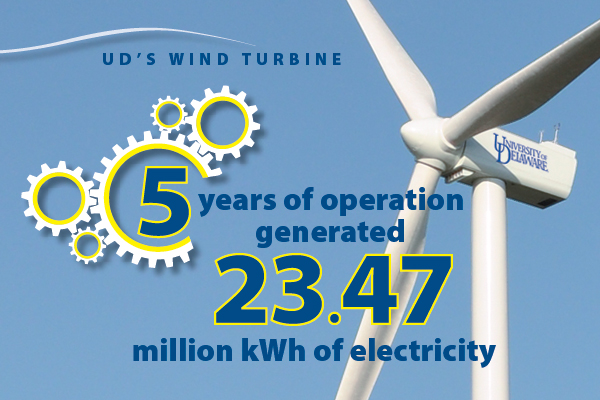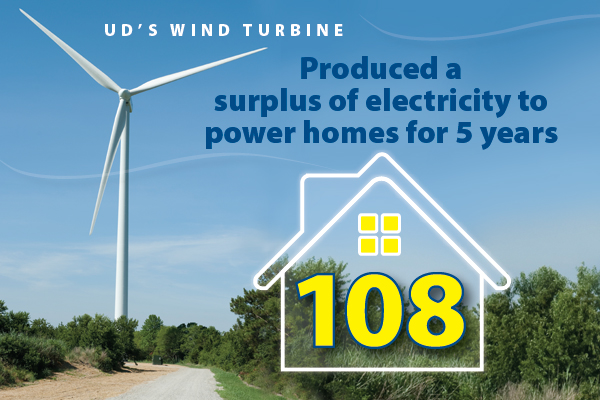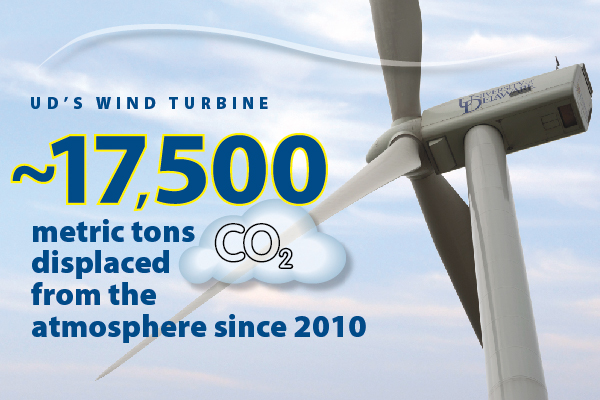Wind turbine turns 5
UD's wind turbine in Lewes marks fifth year of clean energy generation, research
8:25 a.m., Aug. 31, 2015--According to a recent Department of Energy report, wind power is expected to contribute 35 percent of the nation’s energy by 2050, up from 5 percent today.
Since 2010, the University of Delaware has been a leader in generating carbon-free energy. This past June, UD marked the fifth anniversary of the installation of the wind turbine (a Gamesa G90-2.0 MW model) located on the Hugh R. Sharp Campus in Lewes, a joint collaboration between UD and Gamesa.
Research Stories
Chronic wounds
Prof. Heck's legacy
The turbine has generated 23.47 million kilowatt hours (kWh) of electricity over the past five years, more than enough renewable energy to power the laboratories, offices and other buildings on the Lewes campus.
The Lewes Board of Public Works purchased 5.35 million kWh of the surplus electricity. This is enough surplus energy to power approximately 108 average homes per year for five years.
In total, the turbine has displaced approximately 17,500 metric tons of carbon dioxide from the atmosphere.
“The turbine has performed splendidly, generating carbon-free energy for UD and the people of Lewes, who also have embraced the wind turbine as representing progress toward clean energy” said Jeremy Firestone, professor in the College of Earth, Ocean, and Environment’s (CEOE) School of Marine Science and Policy (SMSP), and director of the Center for Carbon-free Power Integration.
“While the clean energy aspects of the wind turbine have been important, the hallmark of its presence have been the research, teaching opportunities and partnerships it has afforded,” added Mohsen Badiey, acting dean of CEOE.
Fueling wind research
The 2-megawatt turbine includes a 256-foot tower, three 144-foot blades and a 160,000-pound nacelle. Installed by First State Marine Wind LLC (FSMW), a joint venture between the UD-owned Blue Hen Wind and Gamesa, it is the only commercial sized wind turbine in Delaware.
According to Firestone, one of the project’s major successes is the research and development cooperation made possible by the partnership. Proceeds from the energy sales above and beyond those dedicated to ongoing operation and maintenance of the turbine have been used to fund wind energy research and development projects.
One research study, for example, looked at the turbine’s impact on area birds and bats. The turbine sits just one kilometer from the Delaware Bay, which is one of the world’s most important international migratory avian stopover locations. That study showed that the turbine had a very low impact on birds.
A follow-up study with partners at Delaware State University that focused on bats provided an opportunity for Gamesa to test its new Bat Shield control software that considers time of day and year, temperature, wind speed and direction, and allows wind turbine owners to modify a turbine’s operations to account for circumstances that indicate the likely presence of bats. FSMW now routinely modifies the wind turbine’s operation to better protect bats during migration season.
The UD wind turbine was also the test site for Gamesa’s first generator customized for the United States in 2012.This test provided the first opportunity for Gamesa to exchange a generator using the internal crane system built into the 2-megawatt turbine, Philippe Delleville, Gamesa’s vice president of services, said.
Other projects have studied wear and tear on the turbine’s drive train, and whether salty coastal air produces corrosion on the machine’s intricate mechanisms.
A year later, in 2013, UD inked a three-year agreement with the Delaware Municipal Electric Corporation (DEMEC) for the sale of renewable energy credits associated with the generation of wind energy by the wind turbine, with proceeds going to support wind energy graduate student research fellowships in CEOE.
Additionally, to date, five UD students have earned specialty certification to climb the 256-foot tall turbine, a unique skill that will help them stand out when applying for careers in the wind industry.
Educating more than students
While UD students visit the turbine regularly as part of their studies, Firestone said UD’s proximity to Washington, D.C., has made the turbine a popular destination for federal institutions and developers eager to expand their wind power knowledge, too.
In 2011, for example, UD hosted representatives from the U.S. Energy Information Administration (EIA), who were interested in observing the operation of a wind turbine up-close and learning more about UD’s wind energy research and activities.
Locally, the turbine has been used to teach local first-graders about wind power through a collaborative project between Delaware Sea Grant and Smyrna Elementary School teachers. The educational field trip was developed to expose children to science and technology in action, while complementing a science kit curriculum called “Catching the Wind” by Engineering is Elementary that is used in Delaware schools.
One exciting project to emerge from the UD-Gamesa collaboration is the development of the Department of Energy-funded Industry-University Atlantic Wind Consortium aimed at advancing wind turbine technologies and graduate programs in offshore wind power. Led by Willett Kempton, professor of marine science and policy and research director for UD's Center for Carbon-free Power Integration, with funding from the Department of Energy, the project includes academic partners at University of Maryland and Old Dominion University.
About the College of Earth, Ocean, and Environment
UD’s College of Earth, Ocean, and Environment (CEOE) strives to reach a deeper understanding of the planet and improve stewardship of environmental resources. CEOE faculty and students examine complex information from multiple disciplines with the knowledge that science and society are firmly linked and solutions to environmental challenges can be synonymous with positive economic impact.
The college comprises the School of Marine Science and Policy, Department of Geography and Department of Geological Sciences.
CEOE brings the latest advances in technology to bear on both teaching and conducting ocean, earth and atmospheric research. Current focus areas are ecosystem health and society, environmental observing and forecasting, and renewable energy and sustainability.
Article by Karen B. Roberts













